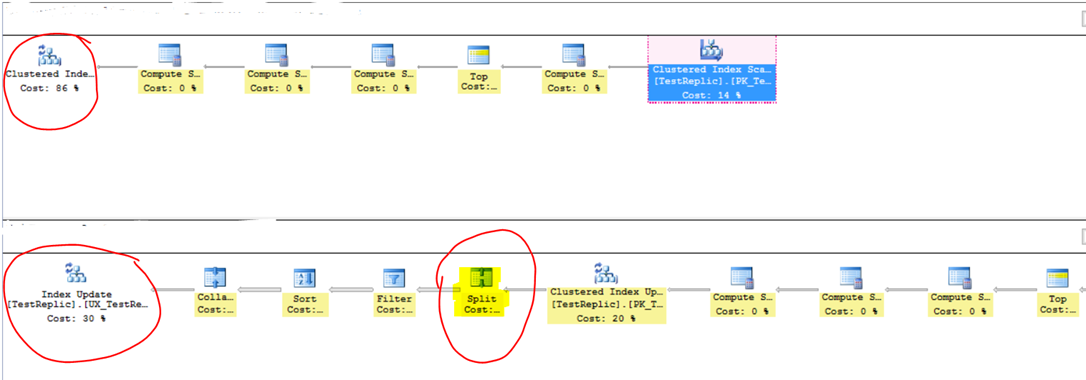Split update operation can result in higher number of replicated commands
In the recent past, we worked on an issue where a number of updates on a replicated article (part of transactional replication) were delivered to the subscriber as a series of DELETEs and INSERTs as opposed to UPDATEs. In this post, I will explain the scenarios under which this situation can occur and what the options are to workaround the situation.
Let us consider a scenario that you are replicating a large table which has a primary key and also a unique non-clustered index. The table and index definitions are provided below.
CREATE TABLE [dbo].[TestReplic](
[id] [int] IDENTITY(1,1) NOT FOR REPLICATION NOT NULL,
[c1] [int] NOT NULL,
[c2] [int] NOT NULL,
[c3] [int] NOT NULL,
CONSTRAINT [PK_TestReplic] PRIMARY KEY CLUSTERED
(
[id] ASC
)WITH (PAD_INDEX = OFF, STATISTICS_NORECOMPUTE = OFF, IGNORE_DUP_KEY = OFF, ALLOW_ROW_LOCKS = ON, ALLOW_PAGE_LOCKS = ON) ON [PRIMARY]
) ON [PRIMARY]
CREATE UNIQUE NONCLUSTERED INDEX [UX_TestReplic_c1_c2] ON [dbo].[TestReplic]
(
[c1] ASC,
[c2] ASC
)
INCLUDE ([c3]) WITH (PAD_INDEX = OFF, STATISTICS_NORECOMPUTE = OFF, SORT_IN_TEMPDB = OFF, IGNORE_DUP_KEY = OFF, DROP_EXISTING = OFF, ONLINE = OFF, ALLOW_ROW_LOCKS = ON, ALLOW_PAGE_LOCKS = ON) ON [PRIMARY]
When you execute an update on a table which updates one of the included columns in the unique non-clustered index, then SQL Server has the option to one of the following:
a. Perform the update as-is and update the clustered and unique non-clustered in a single operation
b. Perform the update as a Split operation by splitting each UPDATE into a DELETE and an INSERT operation. During such a scenario, you will find a SPLIT operator in the UPDATE plan for the table on the publisher.
There are number of heuristics information that SQL Server evaluates to split an UPDATE into a DELETE and INSERT pair. The decision is based on evaluation of a function which determines which of the above options would be better for performance.
When you compare the query plans for the plan with a single UPDATE and the plan with split DELETE and INSERT statements, you will find that:
a. A single clustered index update performs the update for the non-clustered unique index and the clustered index
b. A SPLIT operator appears in the query plan where the indexes are maintained separately. The first operation performed is a clustered index update for the clustered index and another index update for the unique non-clustered index
The screenshot below illustrates the difference.
If you are tracing the replication statements, you will find that the first case will only show the execution of “sp_MSupd_dbo<object name> ” for performing the updates. The second case will show “sp_MSdel_dbo<objectname>” and “sp_MSins_dbo<objectname> ” for the split update scenario.
Tracing the number of commands delivered in the distribution database for a single update or tracking down the query plans or tracking down the stored procedure executions will give you a hint that you have a SPLIT UPDATE in play.
The next question is how do you prevent this from happening. There are a few options that you can exercise:
a. Enable trace flag 2338 at the query level which will prevent the query optimizer from picking per-index plans because of performance. Example of such an update query is shown below.
UPDATE t
SET t.c3=1
FROM dbo.TestReplic tUPDATE TOP(300) dbo.testreplic
SET c3+=1
WHERE c3 = 0 OPTION (querytraceon 2338)
WHERE t.c3 = 10000
Note- Executing a query with the QUERYTRACEON option requires membership in the sysadmin fixed server role. Please read this article for details.
b. The per-index plans are generated for index updates when a large number of rows are affected. So another option would be to perform the update in smaller batches.
c. Alternatively, you could create a stored procedure which would perform the UPDATE and then add the stored procedure as a replicated object to your publication. Please read this article for more information on how to publish stored procedure execution.
Wish all of you a Happy New Year in advance from the Tiger team!
Comments
- Anonymous
January 03, 2017
Hi Amit,Happy new year to you and your team !!I modified your script as follow - Now TestReplic got one PK and two NCI. CREATE TABLE [dbo].[TestReplic]([c1] [int] NOT NULL PRIMARY KEY NONCLUSTERED, [c2] [int] NOT NULL) GOCREATE UNIQUE NONCLUSTERED INDEX [UX_TestReplicc2] ON [dbo].[TestReplic]([c2] ASC )Default configuration of publication allow replicating unique key constraints but not NCI and on subscriber I could see one NCI was created associated with PK. Are you sense any trouble with this set up ? Last time we found duplicate records on subscriber table. Not sure if apart from PK table should have clustered index as well. We are unable to reduce the issue.Thank you for your time !!- Anonymous
January 11, 2017
Are you able to reproduce the issue? If yes, then I would recommend opening a support incident. What you are stating is a different issue and needs to be investigated as I am not aware of duplicates being introduced with replication on recent release.- Anonymous
January 11, 2017
Hello Amit,Thank you for taking time to reply.We are unable to reduce the issue and replication set up in question no longer exists. Have a Great day !!
- Anonymous
- Anonymous
